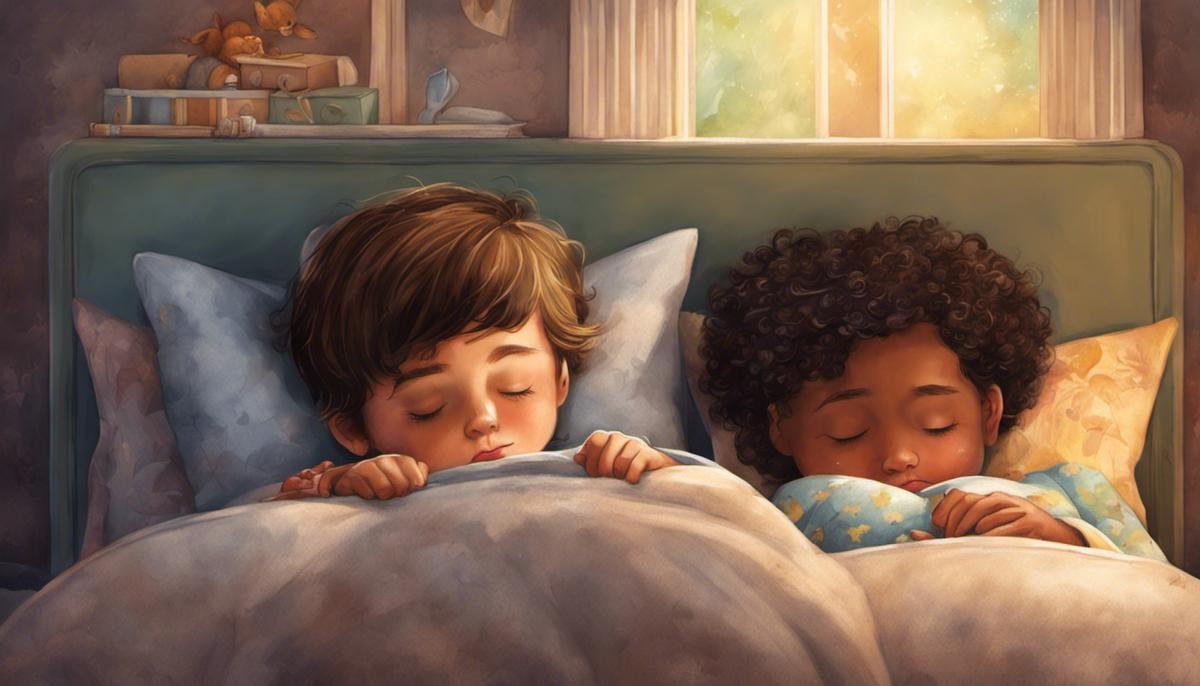
Autism, a developmental disorder that impairs social interaction and communication, is often accompanied by a variety of sleep-related issues. Sleep disorders among children diagnosed with autism are not only common but can significantly impact their daily life, affecting their mood, behavior, and overall health. Despite these challenges, many parents remain uninformed about the existence, triggers, and management of these disorders. By elucidating the intersection of autism and sleep disorders, we hope to assist parents in identifying signs of sleep disturbances in their kids, effectively manage them, and in the process render a positive impact on the quality of life for the child and family. This comprehensive exploration delves into the crucial aspects of understanding autism-related sleep disorders, common triggers and symptoms, practical tips for managing these disorders, the impact on family life, and the importance of building a supportive community.
Understanding Autism-Related Sleep Disorders
Understanding Autism-Related Sleep Disorders in Our Little Ones
Understanding the world of children with autism can often be a labyrinth due to its complexities. A commonly faced difficulty that isn’t discussed enough is sleep-related issues. They can significantly impact a child’s health, behavior, and overall development. Let’s dive deep to comprehend more about autism-related sleep disorders commonly observed in children.
Research indicates that sleep disorders are more prevalent in children with autism than their peers. Up to 80% of children with autism suffer from sleep problems. The most common issues include difficulties in falling asleep, insomnia, and sleep onset delay. Other interesting manifestations of sleep issues include parasomnias such as night terrors and sleep walking.
Insomnia and Sleep Onset Delay:
When it comes to children with autism, we often see that they have trouble initiating sleep or maintaining sleep. Restless nights can cause children to feel tired and irritable the following day. Sleep onset delay is difficulty with falling asleep at an appropriate time. So, if bedtime is at 8 pm, they may toss and turn until 10 pm or later.
Parasomnias:
Parasomnias, unusual behaviors during sleep, are common in children with autism. This includes sleep walking, night terrors, and others. While sleep walking may seem harmless, it poses a safety concern as a child can accidentally hurt themselves. Night terrors, on the other hand, can be quite intense and scary for a child to experience.
Why Do Sleep Disorders Occur?
Sleep problems in children with autism may be due to various complexities. It can include physiological factors like low melatonin levels. Melatonin is a hormone that helps regulate sleep-wake cycle; low levels can disrupt sleep. Sensory issues could be another cause. They may be oversensitive to nighttime noises or the feel of their pajamas or bedsheets. Another factor could be anxiety, which is more common in children with autism.
What Can We Do?
While dealing with sleep disorders in children with autism may seem challenging, there are several strategies that can help. Developing a regular sleep schedule, creating a calming bedtime routine, and ensuring a sleep-friendly environment can make a huge difference in helping a child sleep better. Consulting with a healthcare provider can lead to personalized solutions, like melatonin supplements or therapy.
Remember, patience is key. Some nights may feel endless, and some days may feel twice as exhaustive. It’s important to not lose hope during these times. As much as sleep disorders are part of much of the autism journey, so is making progress and finding solutions that work best for your little one. The same principle works for almost everything surrounding the enigmatic world of autism – consistent effort, patience, and most importantly, warm-hearted understanding will go a long way.

Common Triggers & Symptoms of Sleep Disorders in Autistic children
It’s undeniable that a majority of children with autism spectrum conditions face unique challenges when it comes to achieving restful sleep. Though we’ve already covered the common sleep issues and potential solutions, it’s crucial to delve into the triggers and symptoms in order to uphold the peace of your youngster’s slumber.
When it comes to triggers, studies suggest that irregular circadian rhythm is a key factor contributing to sleep disturbance in children with autism. Simply put, circadian rhythm is the body’s internal clock that regulates when we feel sleepy or alert over a 24-hour period. Due to certain neurophysiological conditions, this internal clock tends to function differently in autistic children, causing them to either fall asleep or wake up at inappropriate times.
Moreover, medical problems such as gastrointestinal discomfort, allergies, or asthma can also prevent them from experiencing restful sleep. Pair these with the heightened sensory sensitivities commonplace in autistic children, wherein even minutiae like the texture of bedding or ambient noise could disrupt their sleep, and achieving a full night’s rest becomes a real struggle.
Even co-existing psychiatric conditions, such as attention deficit hyperactivity disorder (ADHD) and anxiety, may contribute to sleep issues. These conditions can potentially affect a child’s ability to both fall asleep and stay asleep.
It’s equally important to consider diet, as certain food and drink can dramatically affect sleep. Artificial coloring and preservatives in processed foods, as well as caffeine and sugar, can trigger sleep disturbance.
While understanding the triggers, parents should also keep an eagle eye for symptoms suggesting disturbed sleep. Aside from the obvious symptom of tiredness, look out for irritability and hyperactivity. These could be signs of insufficient sleep or fragmented sleep patterns.
Another key symptom to look out for is excessive daytime sleepiness (EDS). Despite experiencing fragmented sleep at night, the lack of quality sleep may induce unintended sleep episodes during the day. Don’t mistake them for frequent naps; they’re a call for action.
Lastly, if your child frequently wakes up at night, possibly coupled with instances of night sweats or nightmares, take it as a red flag indicating possible sleep disruptions.
In truth, managing sleep disturbances in children with autism can be a real-life Hercules task. Yet the secret lies in first understanding the triggers and symptoms, therefore equipping yourself to create the best possible plan for your child.
Bear in mind, each child is unique and what works for one might not work for another. Ultimately, your undying patience, understanding, and the unique bond with your child will guide you through the night to the dawn of a peaceful slumber. Believe in yourself, for you are the biggest pillar of support your child has. Happy Parenting!

Managing Sleep Disorders in Autistic Children
When we’re talking about creating a beneficial sleep environment for kids with autism, it’s crucial to understand the complexity of the problem. Many facets contribute to sleep issues in children with autism, beyond the common factors we’ve already discussed. Undeniably, it’s not a single-pronged issue that can be solved in one fell swoop. Let’s explore these additional dynamics and find out how we can develop appropriate sleep practices.
Children with autism often struggle to regulate their circadian rhythms, which can trigger sleep disturbances. This internal biological clock handles sleep-wake cycles. When out of sync, it can result in erratic sleep patterns. Some strategies that can help regulate circadian rhythms include exposing children to natural light during the day, limiting exposure to digital screens before bed, and ensuring a dark, restful environment at night.
Moreover, medical conditions like gastrointestinal discomfort, allergies, and asthma can be a factor. Ensuring that any co-existing medical conditions are adequately treated can dramatically improve a child with autism’s quality of sleep. Consulting with the child’s pediatrician can help identify these medical issues that might be causing trouble with sleep.
Sensory sensitivities often affect children with autism, and these can extend to bedtime too. Adjusting the sleep environment, such as selecting soft sleep furnishings and using calming sounds, can make a substantial difference.
Further, certain psychiatric conditions, such as ADHD and anxiety, can exacerbate sleep issues. It’s crucial that these conditions are addressed directly, allowing for a more holistic approach to improving sleep. Therapy and medication, as suggested by a health professional, can make a significant impact.
Diet plays an undeniable role in sleep quality. It’s hard for anyone to sleep on a sugar high, and this can also apply to kids with autism! Limiting consumption of artificial coloring, preservatives, caffeine, and excess sugar could lead to a marked improvement.
Watch for symptoms of disturbed sleep—tiredness, irritability, hyperactivity, and excessive daytime sleepiness (EDS). Nighttime wake-ups, night sweats, and nightmares can also be red flags for sleep disruptions. It’s crucial to stay vigilant and address these symptoms proactively.
Understanding triggers and symptoms allows us to create an individualized sleep plan tailored to each child with autism – because no two children are the same. Research is paramount, whether reading up on professional advice or reaching out to a supportive online community of parents facing similar challenges.
Patience, understanding, and the unique bond between a parent and child are paramount in managing sleep disturbances. It’s a journey of trial and error, with different solutions working for each unique child. Remember, the love for your child fuels the perseverance needed to help them conquer their sleep-related challenges. You’re doing a great job, and you’re not alone in this journey.
Let’s continue to join forces, share knowledge, and create a loving, understanding world for our kids with autism—one good night’s sleep at a time. Together, we can better understand these sleep disruptions and find beneficial strategies to support our loved ones.

The Impact of Sleep Disorders on Family Life
As we delve deeper into the complexities of sleep disruptions in children with autism, it’s essential to step back and evaluate how this issue impacts the family dynamic as a whole. After all, sleep disturbances don’t just affect the child – they touch each family member, often throwing the family routine and harmony into disarray. That is why understanding, patience, compassion, and communication become critical tools in navigating this challenge as a family unit.
When a child does not get the sleep they require, parents and siblings often suffer the repercussions as well. Exhausted caregivers may lose their emotional equilibrium more quickly, becoming frazzled and pressing their overall patience to the brink. Siblings may feel a tad overlooked as their parents invest a considerable amount of time and energy into helping their brother or sister struggling with sleep disruptions.
But here’s the thing: it’s not about blame, nor about wishing for a different scenario. Instead, it’s about embracing the distinctive journey each family embarks on with a significant dose of acceptance, flexibility, and resilience.
Now then, how can families uphold their tranquility and happiness through these challenges? For starters, self-care is not just a suggestion, it’s a prerequisite. Parents need to prioritize their physical and mental health – not just for their well-being – but to remain sturdy pillars of support for their entire family.
Adopting behavior strategies such as Parent-Child Interaction Therapy (PCIT) can remind parents we’re all in this together, bolstering understanding, patience, and the reinforcement of positive behaviors. This unique therapy involves coaching parents to interact with their child in a way that enhances the parent-child relationship and encourages a healthy sleep pattern.
Moreover, seeking family counseling can greatly assist everyone. Having a safe space to voice feelings and worries can work wonders for family unity, providing healthier coping mechanisms to handle the stressful situation.
Ensuring everyone involved in the child’s care is in the loop and coordinated is also substantial. Including teachers, doctors, therapists, or anyone else involved ensures a consistent approach to addressing the child’s sleep issues.
Lastly, something as simple as ensuring that siblings aren’t neglected in the whirlwind of strategies, interventions, and treatments can be monumental in keep the family united. Spending quality one-on-one time with other children can aid in making them feel valued and seen.
Autism and its associated sleep disorders brings challenges, no doubt. But that doesn’t mean happiness and harmony can’t thrive within the family. Challenges can also pave the way for growth, resilience, and a deeper sense of family unity. It’s a journey, just like any other aspect of family life, filled with both uphill climbs and moments to pause and take in the view.
Remember, while every family’s journey with autism is unique, no one has to unduly tread this road solo. Reach out, connect, and create a solid network because, rest assured, numerous families are moving forward on this journey as well. Families aren’t just about shared blood; they’re about shared struggles, shared joy, and countless shared moments of understanding. Together, we can navigate the complexities of autism-related sleep disorders and keep building families of resilience, understanding, and boundless love.

Building a Supportive Community & Network
While finding the most effective solutions for a child’s sleep disturbances, it’s highly beneficial to keep in mind the ways it affects the entire family dynamic. Every member of the family, especially parents and siblings, is equally impacted by the sleep-related issues of a child with autism. It changes their routines, tests their patience, and often take a toll on their health and well-being.
Understanding, patience, and compassionate communication are not just necessary for the child but are also pivotal in ensuring seamless navigation through these challenges as a family. A family that understands and supports one another can weather any storm together.
As parents, it often becomes easy to neglect one’s own needs while caring for a child, particularly when the child has a chronic neurodevelopmental disorder like autism. However, it’s crucial to prioritize self-care. Strenuous routines can lead to burnout, affecting one’s ability to provide the necessary support for the child. A healthy mindset and body ensures you’re always there as the sturdy pillar your child needs.
Turn to behavior strategies such as Parent-Child Interaction Therapy (PCIT). This therapy helps improve the quality of parent-child relationships and reinforces positive behaviors while reducing negative ones. It’s a hands-on practice that involves a coach, and is proven to reduce the stress experienced by parents of children with autism.
Pursuing family counseling helps create healthier coping mechanisms, not only for the parents but for the siblings too. Professional guidance can equip your family with valuable tools and insights in managing the effects of autism-related sleep disorders and fostering a healthy and positive environment at home.
Coordination amongst everyone involved in the child’s care — from family members to caregivers and therapists — is another critical step in the process. With consistent communication, you can implement the same strategies at home and school, helping the child adjust better.
Siblings, often the overlooked ones in these dynamics, need attention too. Make it a point to spend quality time with them, ensuring they are not feeling neglected. Explain the situation to them in a way they can understand and involve them where possible so that they too feel a part of the solution.
Facing autism-related sleep disorders can certainly be challenging. But remember, this journey is also riddled with moments of growth, resilience, and deep bonds. In the process of helping your child navigate through sleep issues, the whole family can cultivate patience, compassion, and understanding at deeper levels.
Finally, don’t underestimate the power of reaching out. Connect with other families dealing with similar challenges, join online forums, participate in local meet-ups. Not only can you gain some practical advice, but these connections also provide emotional support. Embracing a community extends your support system and enriches your understanding of autism and its associated challenges.
Building a supportive community includes creating understanding within your family, reaching out to others on a similar journey, and seeking professional help. Remember, you’re not alone in this. With more and more resources being dedicated to autism, help is always around. Your child may face sleep disturbances, but horizon to better sleep and brighter days is within reach.

For families touched by autism, dealing with related sleep disorders can be a challenging journey. Nevertheless, recognizing the issue and understanding its triggers, symptoms, and management methods can pave the way to substantial improvement. Armed with this knowledge, parents can establish healthier sleep patterns for their children, mitigate the ripple effects on family life, and reach out to professionals and support groups for additional assistance. By constructing a strong support network, families can deal with the pressures more effectively and ensure an enriched life for their child. Awareness is the beacon that can guide families into a coping mechanism and transform their challenging journey into a voyage of love, tenderness, and resilience.




